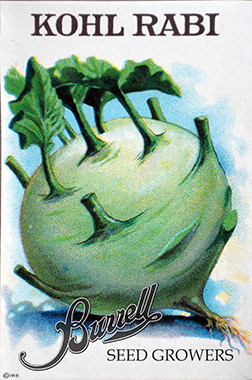Your cart is currently empty!
Kohlrabi
Growing Kohlrabi.
Kohlrabi, or “Cabbage Turnip” as it is called in Germany, is a sweet, crunchy, tuber like vegetable that grows above ground. Slice thin for raw kohlrabi chips and dip, shred for slaw or cut and bake for kohlrabi fries. Cut into bite sized chunks for curried kohlrabi or a creamy kohlrabi stew. Once you grow it, you will find many delicious ways to serve it.
A cool season vegetable, kohlrabi is easy to grow. It is a light feeder and resistant to most garden pests. This crazy, cabbage cousin can be planted late summer and harvested into early winter in warm areas. Kohlrabi grows fast, so successive plantings can start early spring and continue through fall. A light frost makes them sweeter. Pick small kohlrabi for fresh eating. Use large ones for soups and stews.
Plant kohlrabi seeds 1/4″ to 1/2″ deep in rows 10″ to 12″ apart. When seedlings are about 4″ tall, thin to 5″ apart. Keep evenly moist and well weeded. Mulching helps with both. After harvesting, cut off stem and leaves, wrap with moist towel or place in loosely open plastic bag in refrigerator. Kohlrabi can be blanched and frozen for use in soups or stews later.
Good companion crops are bush beans, beets, celery, cucumbers, lettuce, onions and potatoes. Bad companion crops are tomatoes and members of the cabbage family.
-
 Kohlrabi – Early White Vienna$2.60 – $22.60
Kohlrabi – Early White Vienna$2.60 – $22.60 -
 Kohlrabi – Purple Vienna$2.60 – $22.60
Kohlrabi – Purple Vienna$2.60 – $22.60